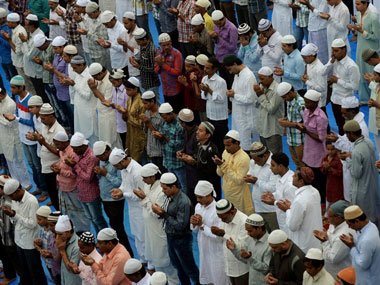Saudi cleric calling Iranians ‘non-Muslims’ and deriding Zoroastrians is religion-based persecution
The ideological rift between Saudi Arabia and Iran over a religious dispute turned nastier when the Saudi Grand Mufti Abdul Aziz al-Sheikh declared that “Iranians are not Muslims”, as reported by several international news agencies including the Reuters.
The current Saudi Grand Mufti (the chief Islamic jurist also called mufti al-a’azam in Arabic terminology), Abdul-Aziz ibn Abdullah Aal ash-Sheikh is also the head of the chief Islamic organization in Saudi Arabia established by the Saudi King called “The General Presidency of Scholarly Research and Iftaa”, which is popularly known among the Arabs as “al-Lajnah ad-Daa’imah lil-Buhooth al-‘Ilmiyyah wal-Iftaa” (permanent committee for conducting Islamic researches and issuing religious decrees or fatwas).
In an intolerant and xenophobic reference to Zoroastrianism, the pre-Islamic religion in Iran, Grand Mufti Abdulaziz al-Sheikh stated, “We must understand that these (Iranians) are not Muslims, because they are children of Magi and their hostility towards Muslims is age-old, particularly with the people of Sunnah”, as reported in the Saudi daily “Makkah”, which covers local and regional news. It actually goes in Arabic as follows:
يجب أن نفهم أن هؤلاء ليسوا مسلمين، فهم أبناء المجوس، وعداؤهم مع المسلمين أمر قديم وتحديدا مع أهل السنة والجماعة
(We must understand that these are not Muslims, they are the sons of the Magi, and their hostility to Muslims is old and specifically with the Sunnis and the community)
In this religiously bigoted statement, the term ‘Magi’ implies Zoroastrianism — natively known as Mazdayasna, which is one of the world’s ancient religions prevailing in Iran and other Persian lands in the pre-Islamic era. Combining a cosmogonic dualism and eschatological monotheism in a distinctive way, Zoroastrianism had emerged as a monotheistic religion. According to an Iranian census, there are still 25,271 Zoroastrians in the country, as the UAE-based daily The National reported.
This Iranian census also tells us that among the total population of the country, which is 75.2 million, Muslims constitute 99.4 per cent. Clearly, Iran has larger population of Muslims than any other country in the Middle East except for Egypt, where the Muslims are numbering 81 million, according to the World Bank.
But the Saudi-Salafi Grand Mufti declares all the 99.4 percent of Iranians, who avowedly profess and practice Islam as their religion, as “non-Muslims.” Is it only a sectarian slugfest between the Shiite and Sunni denominations of Islam calling each other beyond the pale of the true Islamic creed, or much more than that? Of course, Shiites are the majority in most parts of Iran, but there are considerable cities in the country like Simnan where Sunnis are in the majority. Most of them are Kurdish people who came from Larestan, Turkomen, and Baluchs, and are presently living in the northwest, northeast, south, and southeast Iran.
But the chief Saudi cleric Abdul-Aziz ibn Abdullah has uttered disparaging comments, which deride not only the Shiites but also Iranian Sunni Muslims living in different parts of the country with an estimated 10 percent of their population. He declared the Iranians as “enemies of Islam and the Islamic creed”.
One would argue that Shaikh Abdul-Aziz ibn Abdullah might be particular in his statement making it only about the Iranian regime and its religious leader Ali Khamenei. And thus he is merely serving the political interests of the Saudi King who appointed him as the most influential Muslim religious and legal authority for the global Muslims. But there is a good reason why not only the regime but also the 99.4 percent of Iranians (Muslims) are aghast at this virulent public statement by the Saudi Grand Mufti. He buttresses a nasty theological underpinning to declare all the Iranians as “Non-Muslims” and “enemies of Islam” (a’ada al-Islam). In its report dated on 7 September, The Arab News quotes how the Saudi-Salafi Grand Mufti describes the Iranian Muslims:
“They are the followers of ‘majuws’ i.e. ‘those who worship fire’ (referring to the Zoroastrians). Their enmity toward Muslims is old and their main enemies are the followers of Sunnah”.
Tellingly, the Saudi Grand Mufti’s theological tirade against the Iranian Muslims calling them ‘descendents of the fire worshippers’ comes in the backdrop of the Iranian Supreme Leader Khamenei’s remarks. Ayatollah Ali Khamenei recently questioned the Saudi management of the annual pilgrimage— Hajj, urging the Muslim countries to think of ending the Saudi monopoly over the sacred Muslim tradition. Notably, this global Islamic worship ushers in a great economic turnaround for Saudi Arabia. While Islamic edicts of the Hajj rituals require from the pilgrims great deal of simplicity, spirituality and easiness, the Saudi custodians of the two holy cities (Mecca and Medina) have turned it into a big business.
Most terribly, the Saudi monarchy allowed the destruction of religious and culture heritage venerated by the mainstream Muslims—both Sunnis and Shiites. The destruction of the religious, archaeological, historical and cultural heritage of Islam occurred mainly in the Hejaz region of western Saudi Arabia, particularly in the two holy cities of Mecca and Medina. In fact, the radical Saudi clerics like Shaikh Abdul-Aziz ibn Abdullah were behind this Saudi cultural destruction. They strictly adhere to the Wahhabism—the state religion of Saudi Arabia— an ideology propounded by Muhammad ibn Abdul Wahhab, who first called for the destruction of tombs and mausoleums in the Muslim world. Since then, destroying the cultural heritage is one of the chief postulates in the Saudi Wahhabism.
In 2014, a prominent Saudi academician candidly exposed the worst form of cultural destruction proposed by the Saudi government. It was an ill-designed plan to demolish the tomb of the Prophet Muhammad (pbuh). The Saudi scholar compiled a document that proposed to destroy the tomb of Prophet Mohammed and remove his remains from the grave, as reported in an article on Firstpost.
This was as a part of the virulent sectarian design of the Saudi clergy who have been inspiring the war on the historic heritage of Islam. As a result, nearly all cultural monuments in Saudi Arabia have been vandalised. Once again, the top Saudi cleric has offended the religious sentiments of the entire Iranian Muslim population by his obnoxious remarks which sparked discord across the Muslim world. By making the disparaging remarks about the Iranian Muslims, the Grand Mufti has not only created a sensation in media, but also fanned the fire of a deep-rooted sectarian discord among the Shiites and Sunnis.
However, the Iranian Muslims have caught up with such nefarious news earlier too. This is not an isolated incident. But it is an opportune time for them to critique the hate-driven narratives of Islam that are creating such havoc across the world today. More importantly, they will have to create a genuine quest for promoting inter-sect and inter-community dialogue.
It is equally unsetting that the oldest Iranian religion and its adherents have reportedly been persecuted in a country that originally belongs to them. Zoroastrians are derided not only by the Salafist-Wahhabi clergy in Saudi Arabia but are also treated with suspicion in Iran, which calls itself as an Islamic democracy, as reported in The Guardian.
Like Zoroastrianism, Iran is also the birthplace of the Bahai faith, but regrettably it is now one of those countries where the persecution of Bahá’ís occurs in various forms, despite the fact that the largest Bahá’í population is settled in the same country.
Talking to this writer, Nilakshi Rajkhowa, the director of National Spiritual Assembly of the Baha’is of India said that “the persecution of the Baha’i community in Iran is still a widespread phenomenon which has not yet been addressed by the government”. This has also been corroborated by Shatrughun Jiwnani, the director of the capital’s iconic Baha’i House of Worship at the Lotus Temple, New Delhi.
It was in this backdrop that the global Baha’i community sought the Indian Prime Minister Narendra Modi’s help to overcome the persecution, disheartened by the Iranian government’s indifference to this grave violation of minority rights. It is noteworthy that Iran has accepted just two of the 10 recommendations made by a UN rights panel on ending the persecution of Baha’is. However, the Baha’is have high expectations from the Indian Prime Minster who they think can help ensure their safety in Iran, given the good relations India has with Iran.
The role of Indian people would be more practical and proactive if they raise an international outcry, along with civil society organizations, human rights groups, media personas and people from the field of art and culture. The Indian religious leadership that influences the world can also help in mitigating the minority persecutions in the Muslim countries.
It’s time Indian Muslims—both Sunnis and Shiites— engage into this discourse on the minority rights, in order to raise the public opinion and influence the Saudi and Iranian governments to take up the matter of minority rights into serious consideration.
If I speak from my personal experience, there is a welcome sign of change in India and Iran. While the followers of other faiths have long been disparaged as “sinful people”, many moderate Muslims in the two countries are coming out to question the chauvinistic theocracy of Iran and Saudi Arabia.





